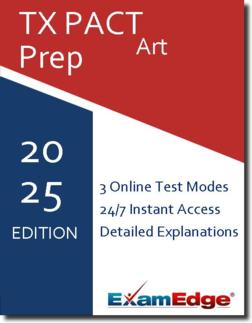TX PACT Art (778) Practice Tests & Test Prep by Exam Edge - Topics
Based on 25 Reviews
- Real Exam Simulation: Timed questions and matching content build comfort for your TX PACT Art test day.
- Instant, 24/7 Access: Web-based TX PACT Art Early Childhood-Grade 12 practice exams with no software needed.
- Clear Explanations: Step-by-step answers and explanations for your TX PACT exam to strengthen understanding.
- Boosted Confidence: Reduces anxiety and improves test-taking skills to ace your TX PACT Art Early Childhood-Grade 12 (778).

Understanding the exact breakdown of the TX PACT Art Early Childhood-Grade 12 test will help you know what to expect and how to most effectively prepare. The TX PACT Art Early Childhood-Grade 12 has 125 multiple-choice questions The exam will be broken down into the sections below:
| TX PACT Art Early Childhood-Grade 12 Exam Blueprint | ||
|---|---|---|
| Domain Name | % | Number of Questions |
| Foundations of Art: Elements and Principles | 11% | 14 |
| Art Media, Tools, Technologies, Techniques, and Processes | 33% | 41 |
| Visual Arts in Historical and Cultural Contexts | 33% | 41 |
| Aesthetics and Art Criticism | 12% | 15 |
| Connecting the Visual Arts to Other Disciplines | 11% | 14 |


